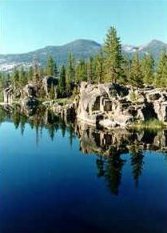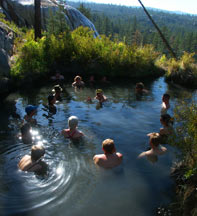
The campground is first come / first serve in September, and is right on the south fork of the San Jaquin River

South fork of the San Jaquin River near camp.

Doris Lake, near camp, is a warm swimming location
2008
This weekend we're going revisit a spot I consider one of the jewels of the Astro 28 constellation of locations - to the High Sierra at Mono Hot Springs. This is northeast of Fresno and is one of the nearer locations which can get us to the dark clean skies of the Sierra. It also is home to a delightful thermal hot spring complex which will allow us to study the gurglings of Mother Earth and talk about inner planet structure and evolution through total immersion (so to speak). This is the site of our Astro 28W course last year, so please check the post-trip photos from that trip
Location (map)
Mono Hot Springs is above Lake Edison, northeast of Fresno and deep into the high country. Directions are on the map on the Astro 28W site. It's at 6,500 ft elevation and has extremely dark skies. We'll be there on the last weekend of September, after the mosquito season is over, after the families and their kids are back in school, and before the cold weather arrives. For google Earth or GPs fans, the coordinates are: Long=119.016W, Lat=37.326N. And here is a link to the topozone.com topographic map of the area. As we get close to our weekend, here's the Weather Underground site to check on the latest weather forecast. There's a small chance that there may be an early Fall storm that comes through and closes Kaiser Pass. If so, we'll move our location to Ponderosa Campground in the southern Big Sur mountains or to the low elevations of Kings Canyon National Park. This is very unlikely, but the pass is not plowed and it is a possibility.
The campground is first come / first serve in September, and is right on the south fork of the San Jaquin River |
South fork of the San Jaquin River near camp. |
Doris Lake, near camp, is a warm swimming location |
September is the ideal time to study the star fields and nebulae of the summer Milky Way. This is the region which contains the center of our galaxy and is home to over 100 thousand million stars. The constellations of Sagittarius, Scorpius, Aquila and Cygnus contain some of the finest deep sky objects in the sky, strewn across the Sagittarius spiral arm of our galaxy about 5 kiloparsecs inside the sun's orbit around the Galaxy. We'll study the Eagle Nebula, the Lagoon Nebula, the North America Nebula, the beautiful supernova remnant known as the Veil Nebula, and a large collection of open star clusters and globular star clusters. All of these objects I've captured in digital photographs which you can see here.
I'd like to do an astrophotography demonstration as well. If we can get a good view of the southern sky, Comet d'Arrest makes a close conjunction with the nice planetary nebula IC 5148 in Grus, but it's only 13 degrees above the horizon so it will be tough.
One of the highlights of the weekend is the occultation of a star by the asteroid Klothilde. This happens at 4am on Sunday (doh!) and you may want to sleep through it. I will have a 10" computer controlled telescope and recording equipment to video-tape the event, Others with telescopes may try and make timings visually. After your delicious breakfast Sunday morning we will study the recording to see how the star disappeared and reappeared from behind the asteroid. Precise timings like this allow us to determine accurate sizes, densities, and shapes of asteroids - valuable for furthering our understanding of these facinating (and scary!) rocks (rubble piles?) from outer space. Other observers may be trying this even from elsewhere along the 50 mile wide path, and combining our observations with theirs will allow a silhouette profile to be drawn of this object. Needless to say, we want to understand all we can about asteroid sizes, composition, chemistry, and structural history because.... they're out there, waiting to smack us (some, anyway).
Planetary Science
We'll also study the planets: In
the evening, there's a beautiful conjunction with Mercury, Venus, Mars, and
the brilliant blue giant star Spica all in central Virgo and setting over the
mountain soon after sunset. Jupiter will dominate the evening sky in Capricorn.
The slender cresent moon will be in Leo, rising during morning dawn. 
 During
the day, we'll take short hikes to study the many and varied springs collectively
known as Mono
Hot Springs by a direct first-hand immersive experience! We'll
hike to Doris Lake and the thermal springs which feed it, study the granite
domes and paint the story of the glaciations which formed them, and have in-the-field
lectures along the way. These lectures will cover the structure of the inner
planets of our solar system, what conditions are needed in order for a planet
to be geologically active, tectonic activity, the geological history of California
and the Sierra, and also rock types and morphology.
During
the day, we'll take short hikes to study the many and varied springs collectively
known as Mono
Hot Springs by a direct first-hand immersive experience! We'll
hike to Doris Lake and the thermal springs which feed it, study the granite
domes and paint the story of the glaciations which formed them, and have in-the-field
lectures along the way. These lectures will cover the structure of the inner
planets of our solar system, what conditions are needed in order for a planet
to be geologically active, tectonic activity, the geological history of California
and the Sierra, and also rock types and morphology.
The Plan
Friday evening you'll carpool your way to the campground. Hopefully we'll have an early bird who can grab a few campsites for us (no reservations after Labor Day). I'll fix a dinner of delicious carbs, then we'll break out the telescopes and study the stars and planets. Bring snacks and chocolate chip cookies (our instructor's weakness) to power us through the crisp evening temperatures. Saturday morning I'll get up early and prep our special breakfast - French Crepes! We'll have a leisurely feed, then hike to Doris Lake. We'll have stops along the way and especially at a beautiful overlook above the lake for micro-lectures on all things geological and planetary. Then we'll enjoy some relaxation time swimming and making vitamin D (i.e. sunning) on the sun-baked Sierra granite around the lake shore. Then lunch and an afternoon hike up to Eden hot springs perched high above in the cliffs across the river (left), where I'll lecture on hot springs formation and the controversial evidence for springs on Mars. Before sunset, I'll cook dinner, with some volunteer help. Saturday night we'll do more observing, focusing on the evening planets before looking deep to the galaxy clusters of Leo and Virgo, as well as star formation regions of the Sagittarius Spiral Arm of our Galaxy. By midnight I expect only the last hardy souls will still be observing. 3am I'll get up and prepare for video-taping the occultation by the asteroid Klothilde, hard-core students are welcome to watch and perhaps assist. Sunday morning we'll have a debriefing on the asteroid event and review the digital video record and draw conclusions on any shifts in the path and/or size of the asteroid. Breakfast will be eggs and hash browns with red peppers and spices. Then a quick final lecture and hot springs soak just across the river a few minutes walk from camp.
Course Grading
Your grades will be based on class participation and enthusiasm, and also on your take-home final exam which you'll mail in to me within 2 weeks of our return. Take note - these classes are important to me, and to the Astronomy program. It's important that I do everything I can to encourage participation by good students who will be responsible. Grading will therefore have some subjective component - a helpful attitude around the group work loads, a willingness to listen to the lectures and participate in the discussions, no swearing, and a strict adherence to the Cabrillo policy of no drugs or alcohol. These classes are always a lot of fun - we blend learning with enjoyment and this makes for the maximum educational impact.. Join us!